Sea grape
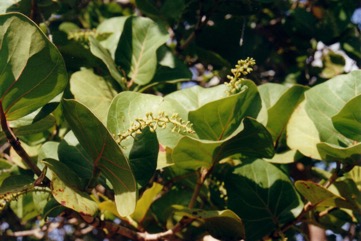
A tropical plant. It is native to tropical America. It can tolerate wind and salt. It has reasonable drought tolerance and can grow in damp soils. It prefers light, well-drained soils in an open sunny position. It is frost tender. Plants normally grow near beaches along sea shores. It adapts well to sandy soils. In Brisbane Botanical Gardens. It suits hardiness zones 10-12.
Also known as:
Jamaican kino, Khrut thale, Kino, Matora, Meybiskadhuru gas, Nho bien, Papaturro, Platter leaf, Pohon anggur laut, Schusterdruif, Shore grape, Sistri-droifi, Uva caleta, Uva de playa, Uva de praia, Uvero
Synonyms
- Polygonum uvifera L.
Edible Portion
- Fruit
Where does Sea grape grow?
Found in: Africa, Asia, Australia, Antigua and Barbuda, Aruba, Bahamas, Barbados, Belize, Bermuda, Caribbean, Cayman Islands, Central America, China, Colombia, Cook Islands, Costa Rica, Cuba, Dominica, Dominican Republic, East Africa, Ecuador, El Salvador, Ghana, Grenada, Guadeloupe, Guatemala, Guiana, Guianas, Guyana, Haiti, Hawaii, Honduras, India, Indochina, Indonesia, Jamaica, Kiribati, Lesser Antilles, Maldives, Marquesas, Martinique, Mexico, Montserrat, Myanmar, Nauru, Nicaragua, North America, Pacific, Papua New Guinea, PNG, Panama, Philippines, Puerto Rico, SE Asia, Senegal, South America, St. Kitts and Nevis, St. Vincent and Grenadines, Suriname, Taiwan, Tanzania, Thailand, Trinidad, Turks & Caicos, Tuvalu, United States, Venezuela, Vietnam, Virgin Islands, West Africa, West Indies
Notes: There are 120 Coccoloba species. In Botanical Gardens in Slovenia presumably in a hot house.
Status: The fruit are sold in markets.
Growing Sea grape
Cultivation: Plants are grown by seed. They can also be grown by cuttings or layering.
Edible Uses: The fruit are used for jam, jelly or wine. They are also used in drinks, soups and syrups. Fruit can be eaten fresh.
Production: It is a moderately fast growing tree. Fruit are produced in 3-4 years. The fruit do not ripen at the same time, so often a cloth is spread under the tree and ripe fruit collected as they fall when the branches are shaken.
Nutrition Info
per 100g edible portion| Edible Part | Energy (kcal) | Protein (g) | Iron (mg) | Vitamin A (ug) | Vitamin c (mg) | Zinc (mg) | % Water |
|---|---|---|---|---|---|---|---|
| Fruit | 73 | 1.4 | 1.2 | tr | 17 | - | 79.1 |
Sea grape Photos

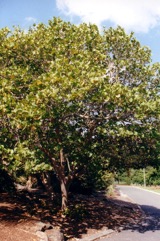
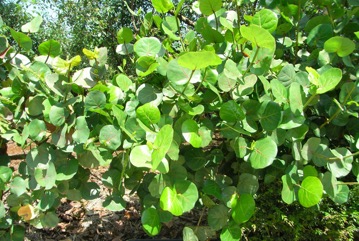
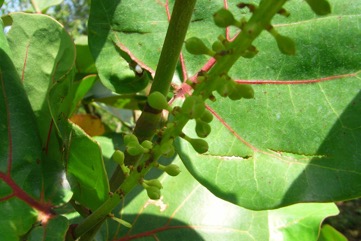
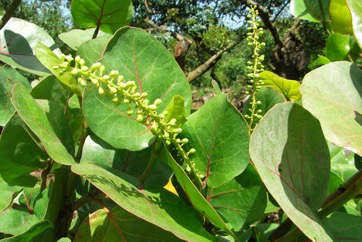
References
Abbiw, D.K., 1990, Useful Plants of Ghana. West African uses of wild and cultivated plants. Intermediate Technology Publications and the Royal Botanic Gardens, Kew. p 42
Ambasta, S.P. (Ed.), 2000, The Useful Plants of India. CSIR India. p 133
Barwick, M., 2004, Tropical and Subtropical Trees. A Worldwide Encyclopedic Guide. Thames and Hudson p 122
Bodkin, F., 1991, Encyclopedia Botanica. Cornstalk publishing, p 269
Burkill, H. M., 1985, The useful plants of west tropical Africa, Vol. 4. Kew.
Chizmar Fernandez, C., et al, 2009, Plantas comestibles de Centroamerica. Instituto de Biodiversidad, Costa Rica. p 260
Coe, F. G., and Anderson, G. J., 1996, Ethnobotany of the Garifuna of Eastern Nicaragua. Economic Botany 50(1) pp 71-107
Coe, F. G. and Anderson, G. J., 1999, Ethnobotany of the Sumu (Ulwa) of Southeastern Nicaragua and Comparisons with Miskitu Plant Lore. Economic Botany Vol. 53. No. 4. pp. 363-386
Condit, R., et al, 2011, Trees of Panama and Costa Rica. Princeton Field Guides. p 370
Coronel, R.E., 1982, Fruit Collections in the Philippines. IBPGR Newsletter p 6
Cundall, P., (ed.), 2004, Gardening Australia: flora: the gardener's bible. ABC Books. p 396
Darley, J. J., 1993, Know and Enjoy Tropical Fruit. P & S Publishers. p 133
Ekman Herbarium records Haiti
Elias, T. S. & Dykeman P. A., 1990, Edible Wild Plants. A North American Field guide. Sterling, New York p 197
Esperanca, M. J., 1988. Surviving in the wild. A glance at the wild plants and their uses. Vol. 2. p 215
Etherington, K., & Imwold, D., (Eds), 2001, Botanica's Trees & Shrubs. The illustrated A-Z of over 8500 trees and shrubs. Random House, Australia. p 218
Facciola, S., 1998, Cornucopia 2: a Source Book of Edible Plants. Kampong Publications, p 184
Flowerdew, B., 2000, Complete Fruit Book. Kyle Cathie Ltd., London. p 163
Grandtner, M. M. & Chevrette, J., 2013, Dictionary of Trees, Volume 2: South America: Nomenclature, Taxonomy and Ecology. Academic Press p 149
Hedrick, U.P., 1919, (Ed.), Sturtevant's edible plants of the world. p 206
Heywood, V.H., Brummitt, R.K., Culham, A., and Seberg, O., 2007, Flowering Plant Families of the World. Royal Botanical Gardens, Kew. p 264
Hibbert, M., 2002, The Aussie Plant Finder 2002, Florilegium. p 71
Hu, Shiu-ying, 2005, Food Plants of China. The Chinese University Press. p 370
Jardin, C., 1970, List of Foods Used In Africa, FAO Nutrition Information Document Series No 2.p 129
Kiple, K.F. & Ornelas, K.C., (eds), 2000, The Cambridge World History of Food. CUP p 1849
Little, E. L. & Wadsworth, F. H., 1964, Common Trees of Puerto Rico and the Virgin Islands. USDA Agriculture Handbook No. 249
Llamas, K.A., 2003, Tropical Flowering Plants. Timber Press. p 318
Lyle, S., 2006, Discovering fruit and nuts. Land Links. p 146
Martin, F. W., et al, 1987, Perennial Edible Fruits of the Tropics. USDA Handbook 642 p 52
May, R.J., 1984, Kaikai Aniani. A Guide to Bush Foods Markets and Culinary Arts of Papua New Guinea. Robert Brown and Associates. p 81
McLaughlin, J., Woody and Herbaceus Plants Native to Haiti. University of Florida. p 15
Miguel, E., et al, 1989, A checklist of the cultivated plants of Cuba. Kulturpflanze 37. 1989, 211-357
Omawale, 1973, Guyana's edible plants. Guyana University, Georgetown p 41
Pham-Hoang Ho, 1999, An Illustrated Flora of Vietnam. Nha Xuat Ban Tre. p 755
Plants of Haiti Smithsonian Institute http://botany.si.edu/antilles/West Indies
PROSEA (Plant Resources of South East Asia) handbook, Volume 2, 1991, Edible fruits and nuts.
Segura, S., et al, 2018, The edible fruit species in Mexico. Genet Resour Crop Evol (2018) 65:1767–1793
Smith, N., Mori, S.A., et al, 2004, Flowering Plants of the Neotropics. Princeton. p 310
Staples, G.W. and Herbst, D.R., 2005, A tropical Garden Flora. Bishop Museum Press, Honolulu, Hawaii. p 463 (Drawing)
Sujanapal, P., & Sankaran, K. V., 2016, Common Plants of Maldives. FAO & Kerala FRI, p 91
Sukarya, D. G., (Ed.) 2013, 3,500 Plant Species of the Botanic Gardens of Indonesia. LIPI p 206
Syst. nat. ed. 10, 2:1007. 1759
Thaman, R. R., 1987, Plants of Kiribati: A listing and analysis of vernacular names. Atoll Research Bulletin No. 296
Thaman, R. R., et al, 1994, The Flora of Nauru. Atoll Research Bulletin No. 392. Smithsonian Institute p 182
USDA, ARS, National Genetic Resources Program. Germplasm Resources Information Network - (GRIN). [Online Database] National Germplasm Resources Laboratory, Beltsville, Maryland. Available: www.ars-grin.gov/cgi-bin/npgs/html/econ.pl (10 April 2000)
van Roosmalen, M.G.M., 1985, Fruits of the Guianan Flora. Utrecht Univ. & Wageningen Univ. p 364
World Checklist of Useful Plant Species 2020. Royal Botanic Gardens, Kew
Zuchowski W., 2007, Tropical Plants of Costa Rica. A Zona Tropical Publication, Comstock Publishing. p 348